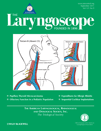Bilateral central serous chorioretinopathy caused by intranasal corticosteroids: A case report and review of the literature†
This work was the recipient of the 2011 Eastern Section Richard J. Bellucci, MD, Resident Research Award and was presented as a poster at the Triological Society Combined Sections Meeting, Scottsdale, Arizona, U.S.A., January 27–29, 2011.
Abstract
The relationship between systemic corticosteroids and central serous chorioretinopathy (CSCR) has been well established; however, there also appears to be an association with intranasal corticosteroids. A search of the English literature revealed only three reported cases of CSCR linked to intranasal corticosteroid use, and in each, clinical improvement was observed after cessation of the steroid agent. We present an additional case of bilateral CSCR resulting from intranasal corticosteroid use and review the literature regarding this uncommon side effect. Otolaryngologists, as frequent prescribers of these medications, should be aware of their myriad side effects, including ophthalmologic conditions such as CSCR.




